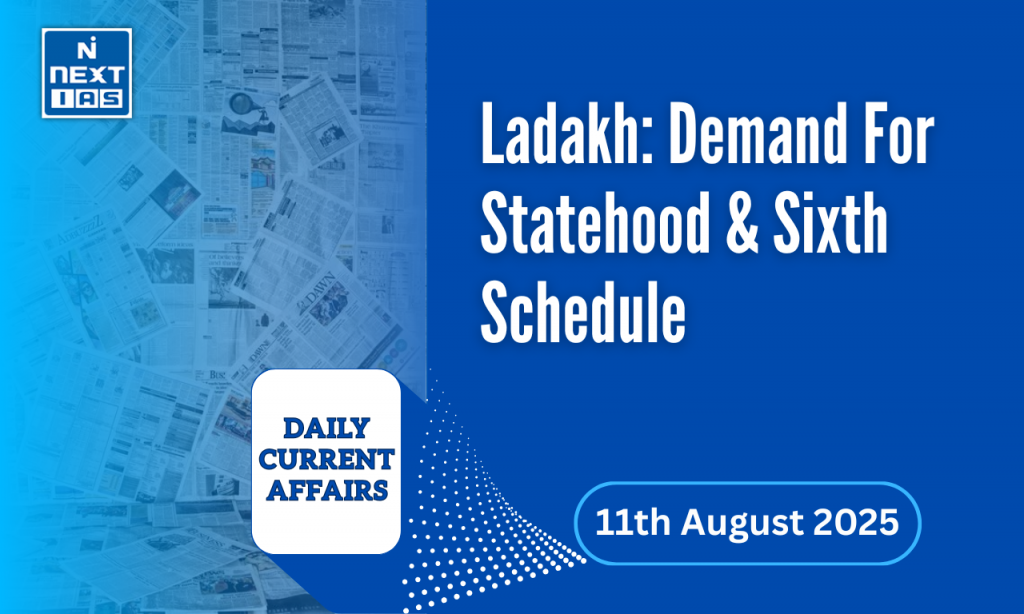
Syllabus: GS2/Governance
Context
- Recently, renowned climate activist and Ramon Magsaysay Award winner Sonam Wangchuk joined a protest, demanding statehood for Ladakh and its inclusion in the Sixth Schedule of the Constitution.
Historical Background
- Historically, Ladakh was part of the erstwhile state of Jammu & Kashmir.
- For decades, Ladakhis felt politically marginalized, with decisions being made in Srinagar that often overlooked the region’s unique cultural and ecological needs.
- After abrogation of Article 370, Ladakh was carved out as a UT without a legislature, under the Jammu and Kashmir Reorganisation Act, 2019.
- It is governed directly by the Lieutenant Governor and the Ministry of Home Affairs (MHA), with limited local decision-making, unlike Delhi or Puducherry.
- However, the removal of Article 35A, which had offered some protection to Ladakh’s land and employment rights, left many feeling vulnerable.
Why Ladakh Became a UT?
- Cultural & Demographic Identity: Buddhist-majority Leh and Shia-majority Kargil are culturally distinct from the Sunni-majority Kashmir Valley.
- Security Considerations: Borders both Pakistan (PoK) and China (Aksai Chin); strategic sensitivity necessitated tighter central control.
- Developmental Goals: UT status intended to improve administrative efficiency, expedite infrastructure, and ensure direct central funding.
Constitutional Basis for State Formation
- Constitutional Provisions:
- Article 3 of the Indian Constitution: Parliament may:
- Form a new state by separating territory from any state or UT;
- Unite two or more states or parts of states or UTs;
- Alter the boundaries or names of existing states;
- Key Requirements:
- A Bill for reorganization needs to be introduced in Parliament only with the President’s recommendation;
- If the proposal affects the area or boundaries of an existing state, the President needs to refer it to that state’s legislature for its views;
- The views of the legislature are not binding; Parliament can proceed regardless.
- Article 3 of the Indian Constitution: Parliament may:
Sixth Schedule Safeguard
- The Sixth Schedule of the Indian Constitution, under Article 244(2) and Article 275(1), provides for the administration of tribal areas in Assam, Meghalaya, Tripura, and Mizoram.
- It allows for the creation of Autonomous District Councils (ADCs) and Regional Councils with legislative, executive, and financial powers over land, public health, agriculture, and local customs.
- Government Mandates and Committees: The MHA constituted a High Powered Committee (HPC) in 2023, chaired by Minister of State for Home Affairs Nityanand Rai. The committee’s mandate includes:
- Exploring constitutional safeguards for Ladakh;
- Strengthening the LAHDCs of Leh and Kargil;
- Ensuring protection of land, employment, and cultural identity;
- Facilitating inclusive development and fast-track recruitment;
- The National Commission for Scheduled Tribes (NCST), in its 119th meeting, recommended that Ladakh be brought under the Sixth Schedule.
- Ladakh has over 97% of its population belonging to Scheduled Tribes and the need to preserve its agrarian and cultural rights.
Related Concerns & Challenges
- Political Mandates: UTs without legislatures lack elected representation and local lawmaking powers.
- Decisions are made by centrally appointed administrators, often disconnected from local realities.
- Cultural and Regional Identity: UTs with distinct ethnic or tribal populations seek constitutional safeguards and self-governance.
- Developmental Equity: Statehood can unlock greater financial devolution and institutional infrastructure.
- Employment and Representation: Locals are demanding a Public Service Commission and job reservations to ensure equitable access.
- Legal and Constitutional Hurdles: The Sixth Schedule currently applies only to certain northeastern states.
- Extending it to a UT like Ladakh would require constitutional amendments and political consensus.
- Administrative Complexity: Ladakh already has two LAHDCs in Leh and Kargil. Integrating these with Sixth Schedule provisions would require careful restructuring to avoid jurisdictional conflicts.
Measures Notified by Union Government for Ladakh
- Reservation in Government Jobs: 85% reservation for resident Ladakhis in government employment;
- Of this, 80% reserved for STs;
- Additional quotas: 4% for residents along the LAC and LoC;
- 1% for SCs; and 10% forEWS;
- Total reservation reaches 95%, among the highest in India.
- Domicile Criteria: Individuals need to prove 15 years of continuous residence in Ladakh from October 31, 2019 (the day Ladakh became a UT), to qualify as a domicile.
- Children of Central government employees, All India Services officers, and PSU staff posted in Ladakh are eligible under specific conditions.
- Women’s Political Representation: One-third of seats in Ladakh’s Autonomous Hill Development Councils (LAHDCs) reserved for women on a rotational basis.
- Official Languages: Ladakh now officially recognizes English, Hindi, Urdu, Bhoti, and Purgi.
- It affirms linguistic diversity and cultural preservation.
- Regulatory Amendments:
- Ladakh Reservation (Amendment) Regulation, 2025;
- Ladakh Civil Services Decentralisation and Recruitment (Amendment) Regulation, 2025;
- Ladakh Official Languages Regulation, 2025;
- Ladakh Autonomous Hill Development Councils (Amendment) Regulation, 2025.
- These provisions mirror similar protections in northeastern states like Mizoram and Arunachal Pradesh, where tribal populations enjoy over 80% reservation in public employment.
Road Ahead
- While the Constitution provides the legal framework, the transition from UT to statehood is ultimately a political decision. It requires:
- Presidential recommendation;
- Parliamentary approval through a reorganization bill;
- Strategic alignment with national interests and regional aspirations.
Previous article
100th Anniversary of Kakori Incident
Next article
RBI’s New Co-Lending Rules